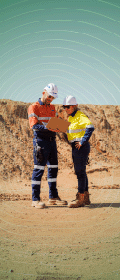GIW Industries has announced the success of a GIW pumping solution that doubled the lifespan of wear parts in the mining operations of a major frac sand producer in the Midwest. The highly-abrasive frac sand mining process causes extreme wear, and pump parts typically need replacement every two years. However, with installation of GIW’s innovative rubber-coated parts, wear life of the pump’s wet-end parts was extended to 3.75 years, when the parts were replaced during scheduled maintenance.
“The parts could have lasted four years,” says Barney Johnson, Director of Sales with ISCO Industries, a distributor of GIW pumps. ISCO oversaw the installation and maintenance of the frac sand producer’s pumps and witnessed the parts’ success firsthand. The hydraulic fracturing process produces petroleum fluids such as oil, natural gas, and natural liquid gas by extracting the material from rock units that lack adequate pore space for fluid movement. Frac sand is used in the process to open that space so the product can flow properly.
Frac sand mining works pumps hard, 24/7, 300 days a year. Most frac sand, made of high purity sandstone, is difficult to pump because of the constitution of the slurry – which can be composed of up to 45% solids.
The high-density frac sand particles constantly churn on metal pipes and pump impellers and on suction liners, quickly eroding the parts. Producers find this wear is a constant problem and leads to frequent maintenance and replacement of components, ultimately reducing operating efficiency.
GIW Aftermarket Sales Representative and Region Manager Angela Bryant explains: “Sand causes the highest wear rates, especially at solids properties less than one-half inch – fine abrasive slurries. In these applications, elastomers such as rubber tend to wear better.” GIW’s rubber-coated parts successfully extend wear life by decreasing metal erosion during mineral processing. Sand particles bounce off the rubber surfaces rather than sliding against the metal, which can grind down the surface more quickly. “Rubber parts, when properly applied, can outlast metal parts three or even four to one,” says Johnson. Making the switch to rubber reduces the frequency of parts replacement, decreasing the need to halt operations during critical production times.
“The partnership of GIW and ISCO in the aggregate industry ensured proper maintenance for these parts and increased longevity of pumping operations for the Midwest frac sand producer. The collaboration between these companies, and the open paths of communication they keep, are helping frac sand mining companies achieve better efficiency in their production.”









